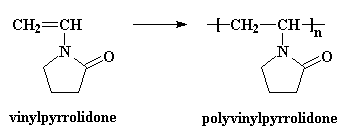

The model on the right above is an image of the pdb model you can view by clicking here or you can just click on the image itself.
Either way, be sure to close the new window that opens up with the 3D model in it when you are ready to come back here.
This polymer worked as a hairspray because it was soluble in water. This meant it could be rinsed out when you wash your hair. But its affinity for water gave it a drawback. Polyvinylpyrrolidone tended to adsorb water out of the air, giving hair that tacky look that was so common in the sixties.
This was fixed with the help of another polymer, a silicone called polydimethylsiloxane. To understand how this silicone made a better hairspray, it helps to understand how the hairspray works in the first place. When you spray it on, the polyvinylpyrrolidone forms a thin coating on the hair. This coating is stiff and keeps the hair from moving around.
Now remember, most of the time, two different kinds of polymers will not. So if we put some of the silicone in the hairspray, the silicone and the polyvinylpyrrolidone will phase separate once they're on the hair. You can see what we get in this picture:

The silicone forms a layer on top of the polyvinylpyrrolidone layer that keeps water out, so the hair has a more natural look.
But that's not all polyvinylpyrrolidone can do. Its found in the glue that holds plywood together. But if want a more exciting use than that, I'll tell you that this polymer can actually save lives. Sometime in the first half of the twentieth century, someone figured out that a patient who has lost a lot of blood can be given blood plasma, and the plasma will help keep the patient alive until whole blood can be administered. But sometimes even blood plasma is hard to find, and we have to figure out how to make the plasma go further. One such time and place is on a battlefield. During the Second World War and the Korean War blood plasma was diluted with polyvinylpyrrolidone, so that more of the injured could be treated with the limited supplies of blood plasma. Of course the much simpler idea of just not having a war in the first place doesn't seem to have occurred to anyone.
Polyvinylpyrrolidone is a vinyl polymer (no! really?) Want to know a how to make this stuff? We make it by free radical vinyl polymerization of the monomer vinylpyrrolidone.

This is what the monomer looks like in 3-D:
The model above is an image of the pdb model you can view by clicking here or you can just click on the image itself.
Either way, be sure to close the new window that opens up with the 3D model in it when you are ready to come back here.

|
Return to Level Two Directory |

|
Return to Macrogalleria Directory |
